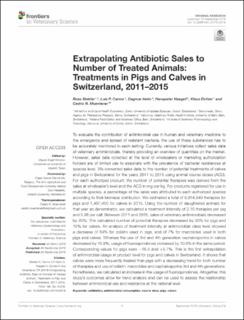Please use this identifier to cite or link to this item:
https://doi.org/10.21256/zhaw-26468Full metadata record
| DC Field | Value | Language |
|---|---|---|
| dc.contributor.author | Stebler, Rosa | - |
| dc.contributor.author | Carmo, Luís P. | - |
| dc.contributor.author | Heim, Dagmar | - |
| dc.contributor.author | Naegeli, Hanspeter | - |
| dc.contributor.author | Eichler, Klaus | - |
| dc.contributor.author | Muentener, Cedric R. | - |
| dc.date.accessioned | 2022-12-20T13:21:05Z | - |
| dc.date.available | 2022-12-20T13:21:05Z | - |
| dc.date.issued | 2019 | - |
| dc.identifier.issn | 2297-1769 | de_CH |
| dc.identifier.uri | https://digitalcollection.zhaw.ch/handle/11475/26468 | - |
| dc.description.abstract | To evaluate the contribution of antimicrobial use in human and veterinary medicine to the emergence and spread of resistant bacteria, the use of these substances has to be accurately monitored in each setting. Currently, various initiatives collect sales data of veterinary antimicrobials, thereby providing an overview of quantities on the market. However, sales data collected at the level of wholesalers or marketing authorization holders are of limited use to associate with the prevalence of bacterial resistances at species level. We converted sales data to the number of potential treatments of calves and pigs in Switzerland for the years 2011 to 2015 using animal course doses (ACD). For each authorized product, the number of potential therapies was derived from the sales at wholesaler's level and the ACD in mg per kg. For products registered for use in multiple species, a percentage of the sales was attributed to each authorized species according to their biomass distribution. We estimated a total of 5,914,349 therapies for pigs and 1,407,450 for calves in 2015. Using the number of slaughtered animals for that year as denominator, we calculated a treatment intensity of 2.15 therapies per pig and 5.96 per calf. Between 2011 and 2015, sales of veterinary antimicrobials decreased by 30%. The calculated number of potential therapies decreased by 30% for pigs and 15% for calves. An analysis of treatment intensity at antimicrobial class level showed a decrease of 64% for colistin used in pigs, and of 7% for macrolides used in both pigs and calves. Whereas the use of 3rd and 4th generation cephalosporins in calves decreased by 15.8%, usage of fluoroquinolones increased by 10.8% in the same period. Corresponding values for pigs were -16.4 and +0.7%. This is the first extrapolation of antimicrobial usage at product level for pigs and calves in Switzerland. It shows that calves were more frequently treated than pigs with a decreasing trend for both number of therapies and use of colistin, macrolides and cephalosporins 3rd and 4th generations. Nonetheless, we calculated an increase in the usage of fluoroquinolones. Altogether, this study's outcomes allow for trend analysis and can be used to assess the relationship between antimicrobial use and resistance at the national level. | de_CH |
| dc.language.iso | en | de_CH |
| dc.publisher | Frontiers Research Foundation | de_CH |
| dc.relation.ispartof | Frontiers in Veterinary Science | de_CH |
| dc.rights | http://creativecommons.org/licenses/by/4.0/ | de_CH |
| dc.subject | Antibiotics | de_CH |
| dc.subject | Antimicrobial consumption | de_CH |
| dc.subject | Calve | de_CH |
| dc.subject | Course dose | de_CH |
| dc.subject | Pig | de_CH |
| dc.subject.ddc | 615: Pharmakologie und Therapeutik | de_CH |
| dc.subject.ddc | 630: Landwirtschaft | de_CH |
| dc.title | Extrapolating antibiotic sales to number of treated animals : treatments in pigs and calves in Switzerland, 2011-2015 | de_CH |
| dc.type | Beitrag in wissenschaftlicher Zeitschrift | de_CH |
| dcterms.type | Text | de_CH |
| zhaw.departement | School of Management and Law | de_CH |
| zhaw.organisationalunit | Winterthurer Institut für Gesundheitsökonomie (WIG) | de_CH |
| dc.identifier.doi | 10.3389/fvets.2019.00318 | de_CH |
| dc.identifier.doi | 10.21256/zhaw-26468 | - |
| dc.identifier.pmid | 31616676 | de_CH |
| zhaw.funding.eu | No | de_CH |
| zhaw.issue | 318 | de_CH |
| zhaw.originated.zhaw | Yes | de_CH |
| zhaw.publication.status | publishedVersion | de_CH |
| zhaw.volume | 6 | de_CH |
| zhaw.publication.review | Peer review (Publikation) | de_CH |
| zhaw.author.additional | No | de_CH |
| zhaw.display.portrait | Yes | de_CH |
| Appears in collections: | Publikationen School of Management and Law | |
Files in This Item:
| File | Description | Size | Format | |
|---|---|---|---|---|
| 2019_Stebler-etal_Extrapolating-Antibiotic-Sales-to-Number-of-Treated-Animals_Forn-Vet-Sci.pdf | 288.29 kB | Adobe PDF |  View/Open |
Show simple item record
Stebler, R., Carmo, L. P., Heim, D., Naegeli, H., Eichler, K., & Muentener, C. R. (2019). Extrapolating antibiotic sales to number of treated animals : treatments in pigs and calves in Switzerland, 2011-2015. Frontiers in Veterinary Science, 6(318). https://doi.org/10.3389/fvets.2019.00318
Stebler, R. et al. (2019) ‘Extrapolating antibiotic sales to number of treated animals : treatments in pigs and calves in Switzerland, 2011-2015’, Frontiers in Veterinary Science, 6(318). Available at: https://doi.org/10.3389/fvets.2019.00318.
R. Stebler, L. P. Carmo, D. Heim, H. Naegeli, K. Eichler, and C. R. Muentener, “Extrapolating antibiotic sales to number of treated animals : treatments in pigs and calves in Switzerland, 2011-2015,” Frontiers in Veterinary Science, vol. 6, no. 318, 2019, doi: 10.3389/fvets.2019.00318.
STEBLER, Rosa, Luís P. CARMO, Dagmar HEIM, Hanspeter NAEGELI, Klaus EICHLER und Cedric R. MUENTENER, 2019. Extrapolating antibiotic sales to number of treated animals : treatments in pigs and calves in Switzerland, 2011-2015. Frontiers in Veterinary Science. 2019. Bd. 6, Nr. 318. DOI 10.3389/fvets.2019.00318
Stebler, Rosa, Luís P. Carmo, Dagmar Heim, Hanspeter Naegeli, Klaus Eichler, and Cedric R. Muentener. 2019. “Extrapolating Antibiotic Sales to Number of Treated Animals : Treatments in Pigs and Calves in Switzerland, 2011-2015.” Frontiers in Veterinary Science 6 (318). https://doi.org/10.3389/fvets.2019.00318.
Stebler, Rosa, et al. “Extrapolating Antibiotic Sales to Number of Treated Animals : Treatments in Pigs and Calves in Switzerland, 2011-2015.” Frontiers in Veterinary Science, vol. 6, no. 318, 2019, https://doi.org/10.3389/fvets.2019.00318.
Items in DSpace are protected by copyright, with all rights reserved, unless otherwise indicated.